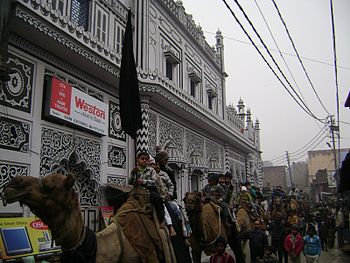Mourning of Muharram

The Mourning of Muharram is an important period of mourning in Shia Islam, taking place in Muharram which is the first month of the Islamic calendar. It is also called the Remembrance of Muharram (Arabic: ذكرى محرم or مناسبة محرم). Many of the events associated with the remembrance take place in congregation halls known as Hussainia.
The event marks the anniversary of the Battle of Karbala when Imam Hussein ibn Ali, the grandson of the Islamic prophet Muhammad, and a Shia Imam, was killed by the forces of the second Umayyad caliph Yazid I. The event is marked by arranging 'majalis' (gatherings) to review Islamic teachings and to commemorate Imam Hussain's sacrifice. The mourning reaches its climax on the tenth day, known as Ashura, on which the forces of Yazid killed the 72 individuals who fought, including Imam Hussain, his family and supporters. The women and children left living were made prisoners and transported to Yazid's court in Damascus. The words Azadari (عزاداری) which mean mourning and lamentation; and Majalis-e Aza have been exclusively used in connection with the remembrance ceremonies for the martyrdom of Imam Hussain. Majalis-e Aza, also known as Aza-e Husayn, includes mourning congregations, lamentations, matam and all such actions which express the emotions of grief and above all, repulsion against what Yazid stood for.
The term majalis has both a grammatical meaning and a meaning which relates to Aza-e-Husayn. In its technical sense, a majalis is a meeting, a session or a gathering.According to Shia sources, The Azadari of Muharram was started by the family of Muhammad (the Ahl-ul-Bayt) after the death of Muhammad's grandson Husayn ibn Ali at the Battle of Karbala in 680 AD. Following the battle of Karbala, Muhammad's granddaughter Zaynab bint Ali and sister of Husayn, began mourning for the fallen and making speeches against Husayn ibn Ali's opponents: Ibn Ziyad and Yazid I. News of Husayn ibn Ali's death was also spread by Imam Zain-ul-Abideen, who succeeded Husayn as the Shia Imam, via sermons and speeches throughout Iraq, Syria and Hejaz.
Zainab and Zain-ul-Abideen informed the people that Yazid had martyred Imam Husayn and seventy-two of his companions including his six month old son Ali Asghar, and that their women and children were taken as prisoners to Syria. When word of mourning reached Yazid he decided to release the captive women and children from the prison in Damascus, out of fear of public revolt against his rule. He sent for Zain-ul-Abideen, informed him of the impending release and asked if he wished for anything further. Zain-ul-Abideen said he would consult with Zainab. She asked Yazid to provide a place where the people could mourn for Imam Husayn and others of Muhammad's household. A house was provided, and here Zaynab binte Ali held the first Majlis-e Aza of Husayn and started the Mourning of Muharram.

